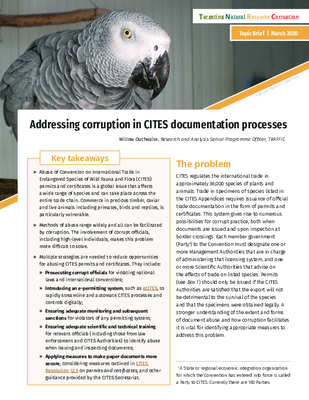Addressing corruption in CITES documentation processes

Abuse of Convention on International Trade in Endangered Species of Wild Fauna and Flora (CITES) permits and certificates is a global issue that affects a wide range of species and can take place across the entire trade chain. Commerce in precious timber, caviar and live animals including primates, birds and reptiles, is particularly vulnerable. Methods of abuse range widely and all can be facilitated by corruption. The involvement of corrupt officials, including high-level individuals, makes this problem more difficult to solve.
Key Takeaways
- Abuse of Convention on International Trade in Endangered Species of Wild Fauna and Flora (CITES) permits and certificates is a global issue that affects a wide range of species and can take place across the entire trade chain. Commerce in precious timber, caviar and live animals including primates, birds and reptiles, is particularly vulnerable.
- Methods of abuse range widely and all can be facilitated by corruption. The involvement of corrupt officials, including high-level individuals, makes this problem more difficult to solve.
- Multiple strategies are needed to reduce opportunities for abusing CITES permits and certificates. They include:
- Prosecuting corrupt officials for violating national laws and international conventions;
- Introducing an e-permitting system, such as eCITES, to rapidly streamline and automate CITES processes and controls digitally;
- Ensuring adequate monitoring and subsequent sanctions for violators of any permitting system;
- Ensuring adequate scientific and technical training for relevant officials (including those from law enforcement and CITES Authorities) to identify abuse when issuing and inspecting documents;
- Applying measures to make paper documents more secure, considering measures outlined in CITES Resolution 12.3 on permits and certificates, and other guidance provided by the CITES Secretariat.


